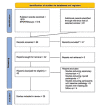A Meta-Analysis of Randomized Controlled Trials on the Effectiveness of Exercise Intervention in Preventing Sports Injuries
- PMID: 35875288
- PMCID: PMC9298606
- DOI: 10.7759/cureus.26123
A Meta-Analysis of Randomized Controlled Trials on the Effectiveness of Exercise Intervention in Preventing Sports Injuries
Abstract
Athletes risk injury every day during practice sessions and actual games, with the majority of the affected population being young males. The Centers for Disease Control and Prevention 2011-2014 report on sport and recreation-related injuries in the United States has consistently shown the average annual estimate of the millions of dollars spent on sport and recreation injuries. These injuries translate to a significant financial implication for the athlete, the team, the health system, and the public health. We composed a review protocol. We enumerated our inclusion and exclusion criteria, injury definition, and search strategy. We searched PubMed and SPORTDiscus. Then we used Forrest plots for the meta-analysis of the relevant selected studies. We used various keywords in our search strategy. These included "injury," "sports," "exercise," "prevention," "techniques," and every possible combination of them. Search results showed 2516 hits with our keywords, and we included 20 of those results. Twenty trials, including 19712 individuals with 2855 injuries, were analyzed. Eccentric Training relative risk (RR) of 0.54 (95% CI 0.395 to 0.739 with X2 of p < 0.05) showed that the risk of the injury was decreased by 54% in the intervention group compared to the control group. In the neuromuscular training group, a RR of 0.682 (95% CI 0.621 to 0.749 with X2 of p < 0.001) showed that the risk of the injury was decreased by 68.2% in its intervention group subgroup compared to its control group. Also, the "11" International Federation of Association Football (FIFA) program had a RR of 0.771, indicating that there was a 77.1% decrease in injury by this set of exercises (95% CI 0.728 to 0.816 with X2 of p < 0.05), and this "11" FIFA program also had the most preventative effects. Warm-up had a RR of 0.843 (95% CI 0.749 to 0.949 with X2 of p < 0.05) and showed small prevention. Strength Training RR of 0.97 (95% CI 0.57 to 1.63 with X2 of p > 0.05) had no preventive effect. Our analysis showed that different exercises have preventive roles in sports injuries. The warm-up FIFA, neuromuscular training, and eccentric training reduced the risk of injury in the intervention group compared to the control group by a high percentage. At the same time, neuromuscular warm-up and FIFA 11 dynamic warm-up also decreased the relative risk of injury in the intervention group. These effects varied among exercise type, injury type, and sport.
Keywords: eccentric quadriceps work; excercise; exercise training; pediatric sports medicine; sports related injuries.
Copyright © 2022, Okobi et al.
Conflict of interest statement
The authors have declared that no competing interests exist.
Figures



Similar articles
-
Does the FIFA 11+ Injury Prevention Program Reduce the Incidence of ACL Injury in Male Soccer Players?Clin Orthop Relat Res. 2017 Oct;475(10):2447-2455. doi: 10.1007/s11999-017-5342-5. Clin Orthop Relat Res. 2017. PMID: 28389864 Free PMC article. Clinical Trial.
-
Effects of balance training on post-sprained ankle joint instability.Int J Risk Saf Med. 2015;27 Suppl 1:S99-S101. doi: 10.3233/JRS-150707. Int J Risk Saf Med. 2015. PMID: 26639734
-
Implementation of the FIFA 11+ Injury Prevention Program by High School Athletic Teams Did Not Reduce Lower Extremity Injuries: A Cluster Randomized Controlled Trial.Am J Sports Med. 2019 Oct;47(12):2844-2852. doi: 10.1177/0363546519873270. Epub 2019 Sep 17. Am J Sports Med. 2019. PMID: 31526276 Clinical Trial.
-
Could targeted exercise programmes prevent lower limb injury in community Australian football?Sports Med. 2013 Aug;43(8):751-63. doi: 10.1007/s40279-013-0056-7. Sports Med. 2013. PMID: 23681448 Review.
-
Injury prevention programs that include balance training exercises reduce ankle injury rates among soccer players: a systematic review.J Physiother. 2022 Jul;68(3):165-173. doi: 10.1016/j.jphys.2022.05.019. Epub 2022 Jun 23. J Physiother. 2022. PMID: 35753965
Cited by
-
Effects of Different Hamstring Eccentric Exercise Programs on Preventing Lower Extremity Injuries: A Systematic Review and Meta-Analysis.Int J Environ Res Public Health. 2023 Jan 23;20(3):2057. doi: 10.3390/ijerph20032057. Int J Environ Res Public Health. 2023. PMID: 36767424 Free PMC article.
-
Association Between Longitudinal Changes in Patellar Tendon Abnormality and Land-Jump Biomechanics in Male Collegiate Basketball Players.Orthop J Sports Med. 2024 Sep 6;12(9):23259671241261354. doi: 10.1177/23259671241261354. eCollection 2024 Sep. Orthop J Sports Med. 2024. PMID: 39253290 Free PMC article.
-
Effects of left thigh blood flow restriction exercise on muscle strength and golf performance in amateur golfers.J Exerc Rehabil. 2023 Aug 22;19(4):237-244. doi: 10.12965/jer.2346302.151. eCollection 2023 Aug. J Exerc Rehabil. 2023. PMID: 37662529 Free PMC article.
References
-
- U.S. Bureau of Labor and Statistics. Athletes and sports competitors. [ Feb; 2022 ];https://www.bls.gov/ooh/entertainment-and-sports/athletes-and-sports-com... 2022
-
- National Health Statistics Reports. Sports- and recreation-related injury episodes in the United States, 2011-2014. [ Jan; 2022 ];https://www.cdc.gov/nchs/data/nhsr/nhsr099.pdf 2016 - PubMed
-
- The Johns Hopkins University. Sports injury statistics. [ Jun; 2022 ];https://www.hopkinsmedicine.org/health/conditions-and-diseases/sports-in... 2021
-
- Sports injury surveillance has everything to do with sports medicine. Janda DH. Sports Med. 1997;24:169–171. - PubMed
-
- Inpatient and emergency department costs from sports injuries among youth aged 5-18 years. Ryan JL, Pracht EE, Orban BL. https://bmjopensem.bmj.com/content/5/1/e000491 BMJ Open Sport. 2019;5:0. - PMC - PubMed
Publication types
LinkOut - more resources
Full Text Sources
